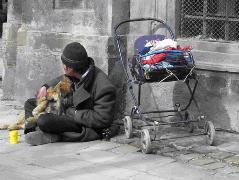Analytics, Estonia, Financial Services, Society
International Internet Magazine. Baltic States news & analytics
Saturday, 10.01.2026, 00:31
7.5% Estonian population lived in relative poverty in 2010
 Print version
Print version |
|---|
In 2010 the income of population decreased and the yearly average unemployment increased. Social transfers (governmental benefits, pensions) helped to prevent the fall in poverty, as they were not included in income, the at-risk-of-poverty rate was even 41.1% in 2010 (in 2009 – 40.8%).
In 2010, a person was considered to be at-risk-of-poverty if his/her monthly equalised disposable income was below 280 euros (in 2009 – 286 euros). Compared to 2009, people’s incomes decreased. This caused the fall of at-risk-of-poverty threshold by six euros. In 2010 the difference in income between the poorest and richest fifth of the population was 5.3-fold.
Similarly to the previous years, it can be noticed that the percentage of younger people who are living in relative poverty is increasing, and that of persons aged 65 and older – decreasing. In 2010, 22% of persons aged 18–24 and 13% of persons aged 65 and more lived in relative poverty. The important reason is the younger age groups’ high unemployment rate and a more stable income in retirement ages compared with other age groups.
By type of household, the at-risk-of-poverty rate has increased the most in households of a couple with three or more children (by 7.2 percentage points) and decreased in households of a single person aged 65 and over (by 6.9 percentage points).
By regions, for the residents in Northeastern Estonia the at-risk-of-poverty rate was nearly three times higher than for the residents in Northern Estonia. Similarly, the poverty risk for people living in rural settlements is significantly higher than for people living in urban settlements.
The level of education significantly affects the remaining in risk of poverty. From persons with basic or lower education every third was in the poorest and only every sixteenth was in the richest income quintile. At the same time one third of people with higher education belonged to the richest fifth. Therefore, the at-risk-of-poverty rate of persons with higher education (7.5%) was more than three times lower than of persons with basic or lower education (25.7%). A good education is an important presumption for the prevention of poverty.
More detailed information can be found at http://statistikaamet.wordpress.com/2011/12/16/suhtelises-vaesuses-elas-mullu-iga-kuues-eesti-elanik/ (only in Estonian).
The estimations are based on the Social Survey, which has been conducted by Statistics Estonia since 2004. In 2011, about 5,000 households participated in the survey. The survey collects data about yearly income, which is the reason why the survey of 2011 asks for data about incomes in 2010. The yearly income is necessary for calculating the indicators of poverty and inequality.
At-risk-of-poverty rate is the share of persons with yearly disposable income lower than the at-risk-of-poverty threshold. At-risk-of-poverty threshold is 60% of the median yearly disposable income of household members. Equalised disposable income is the total household income, which is divided by the sum of equivalence scales of all household members.
Social surveys are conducted on the basis of methodology in all European Union countries by the name of EU-SILC.








 «The Baltic Course» Is Sold and Stays in Business!
«The Baltic Course» Is Sold and Stays in Business!

